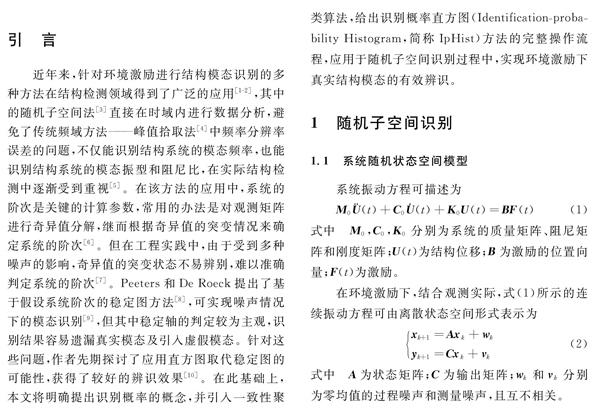环境激励下结构模态辨识的识别概率直方图方法研究
陈太聪 李盈盈 苏成 马海涛



摘要: 在环境激励下辨识结构模态时,系统阶次作为关键计算参数不易准确判定,通常采用基于假设系统阶次的稳定图方法来辅助进行,但其中稳定轴的判定较为主观,容易遗漏真实模态及引入虚假模态。基于数据挖掘技术,提出识别概率直方图(Identificationprobability Histogram,IpHist)的新方法,对不同假设系统阶次下通过随机子空间识别得到的多组备选模态,根据频率容差和模态置信度容差准则进行一致性聚类,继而计算群组聚类结果的识别概率,并绘制相应的识别概率直方图,最后选取识别概率大的结果作为结构模态结果。通过IASCASCE结构健康监测工作组提供的4层框架Benchmark模型算例,阐述了所提IpHist方法在环境激励下辨识结构模态的有效性,显示了方法较强的抗噪能力。
关键词: 模态辨识; 随机子空间; 稳定图; 识别概率直方图
中图分类号: O327; TU317+.1文献标志码: A文章编号: 10044523(2016)04056107
DOI:10.16385/j.cnki.issn.10044523.2016.04.001
引言
近年来,针对环境激励进行结构模态识别的多种方法在结构检测领域得到了广泛的应用[12],其中的随机子空间法[3]直接在时域内进行数据分析,避免了传统频域方法——峰值拾取法[4]中频率分辨率误差的问题,不仅能识别结构系统的模态频率,也能识别结构系统的模态振型和阻尼比,在实际结构检测中逐渐受到重视[5]。在该方法的应用中,系统的阶次是关键的计算参数,常用的办法是对观测矩阵进行奇异值分解,继而根据奇异值的突变情况来确定系统的阶次[6]。但在工程实践中,由于受到多种噪声的影响,奇异值的突变状态不易辨别,难以准确判定系统的阶次[7]。Peeters和De Roeck提出了基于假设系统阶次的稳定图方法[8],可实现噪声情况下的模态识别[9],但其中稳定轴的判定较为主观,识别结果容易遗漏真实模态及引入虚假模态。针对这些问题,作者先期探讨了应用直方图取代稳定图的可能性,获得了较好的辨识效果[10]。在此基础上,本文将明确提出识别概率的概念,并引入一致性聚类算法,给出识别概率直方图(Identificationprobability Histogram,简称IpHist)方法的完整操作流程,应用于随机子空间识别过程中,实现环境激励下真实结构模态的有效辨识。
Abstract: During the modal identification of a structure subjected to ambient excitations, the system order as a crucial computation parameter is not easy to be determined, and the stabilization diagram method based on assumed system orders is often adopted to help the identification. But how to distinguish the stabilization axes is in fact subjective, which may lead to possible inclusion of pseudo vibration modes instead of real modes into the final results. To avoid these problems, an identificationprobability histogram (IpHist) method in use of the data mining technique is proposed in the present paper. Firstly, the stochastic subspace method is applied to identify the alternative modes with different assumed system orders. Then, all the alternative modes are clustered into several categories by using the criteria of frequency tolerance and MAC tolerance, and the identification probability of each category is obtained along with the corresponding identificationprobability histogram. Finally, the clustered modes with large identification probability are chosen to be the structural modes. By taking a fourstory Benchmark model provided by the IASCASCE structural health monitoring workgroup as example, numerical results are presented to illustrate the effectiveness and antinoise capacity of the proposed IpHist method for modal identification of structures subjected to ambient excitations.
Key words: modal identification; stochastic subspace; stabilization diagram; identificationprobability histogram

